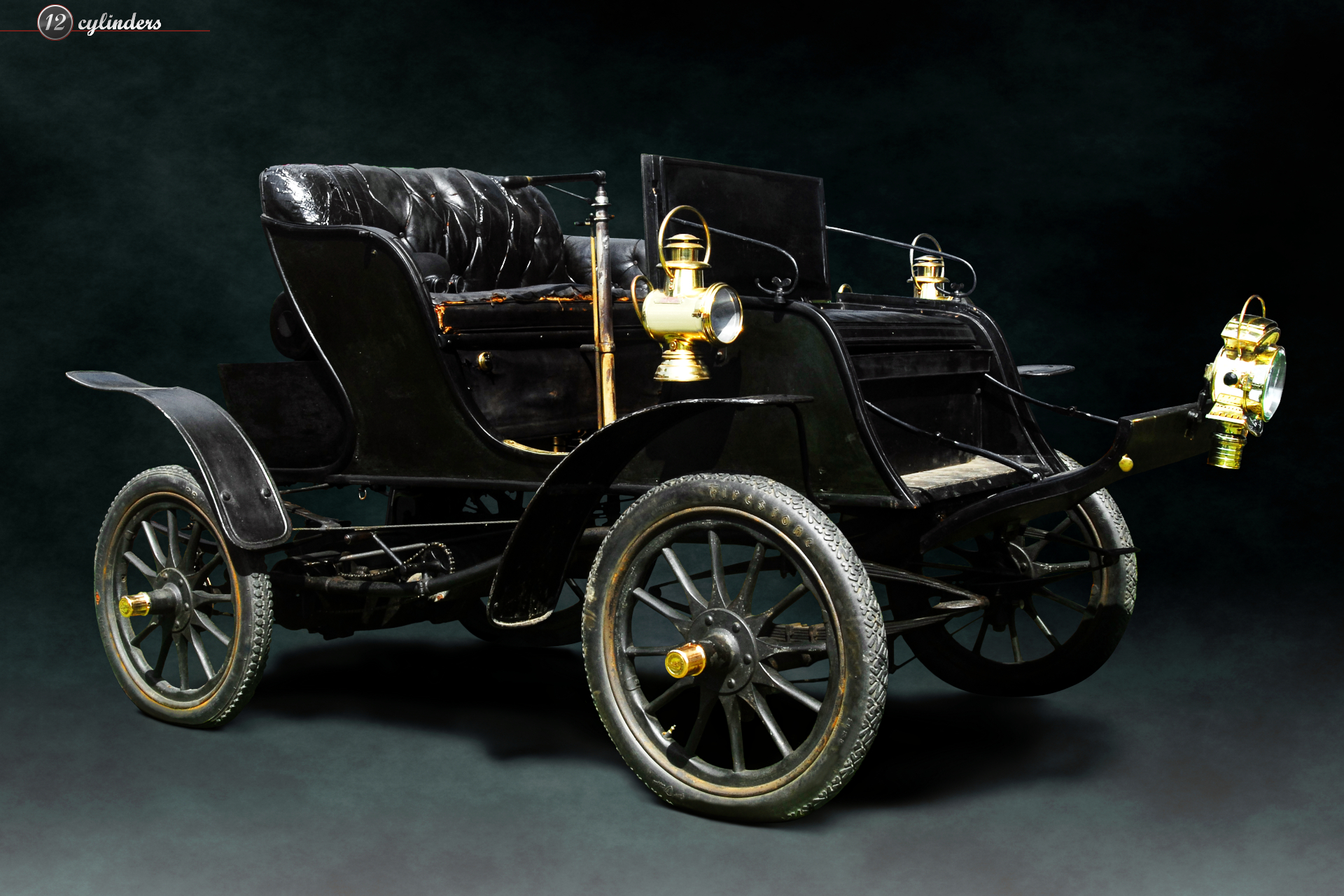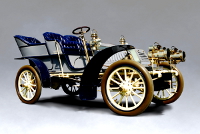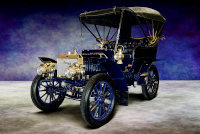Location:
Radnor Hunt Concours d'Elegance, 2007
Owner: Joseph B. Van Sciver, III | Philadelphia, Pennsylvania
Prologue:
Note that while the listing above cites the owner at the time of photography, this Pierce became property of Stephen and Susan Babinsky of Lebanon, New Jersey. The car attended the 2018 Elegance at Hershey, though no new photographs were taken.
We begin the Pierce-Arrow story with the first exercise powered by a Pierce-designed, Pierce-built motor. In the previous two years, Pierce licensed a De Dion single-cylinder unit. The company continued licensing a two-cylinder unit in 1903, as found in the 15 hp tonneau profiled nearby in this collection. So the Stanhope is the first all-Pierce horseless carriage.
For over 15 years, I've kept a series of photographs from the old sensor, unsure of whether to move forward with features if I can only provide one perspective and no detail. But the larger project is worthwhile, and this Stanhope is the best possible starting point. I gently reworked this photo's processing for the main Pierce-Arrow portfolio build in 2023.
- - - - - - - - - -
► Image Source: Nikon D200 (10.2 MP)
References:
- Ralston, Marc. "Pierce-Arrow" A.S. Barnes & Co., Inc., San Diego, CA. 1980, page 13, 19, 230
- Automobile Quarterly's World of Cars, Kutztown Publishing Co. Inc., Kutztown, PA, 1971, page 207-208; adapted from "Pierce-Arrow: An American Aristocrat" by Maurice D. Hendry, Volume VI, Number 3
- RM Sotheby's: RM auctioned this similar 1903 6½ hp Stanhope in 2015.
- Hyman LTD: For comparison, see this 1904 8 hp Stanhope.
- Pierce-Arrow Society: A very brief description of the early Motorette years.
- Smithsonian National Museum of American History: Reference to the 1901 Motorette housed in the Smithsonian collection.
This Stanhope Motorette exemplifies the diligence exercised by the Clifton-Fergusson team at the start of Pierce's motorcar journey; it is unrestored, original, and operable. Having been purchased by the owner of record in 1943, the car had not been shown publicly prior to the 2007 Radnor Hunt Concours d'Elegance, and remains to this day a truly special exhibit we are fortunate to present.
The George N. Pierce Company Experiment with the Motorcar Concept
The Motorette came to be through the experiments of young Percy Pierce, son of namesake George N. Pierce, and Charles Clifton, future president of what would become Pierce-Arrow. Having disposed of steam power through a series of engineering tests, the two engaged English engineer, David Fergusson, with the development of simple, four-wheel runabout with a De Dion 2¾ hp single-cylinder motor built under license. Fergusson's team design and built two runabouts by May of 1901. Automobile Quarterly writes, "for the rest of the year Fergusson and his staff drove around the United States testing the cars and demonstrating them to the George N. Pierce bicycle agents."
The vehicle itself resembled an Oldsmobile Model R, sans curved dash, whereas Pierce preferred the French term 'motorette' to the American 'runabout,' owing to their continental interest and the time Clifton had spent researching the motorcar concept in France. Pierce produced 25 of the original specification Motorette in 1902, revised the design with a 3½ hp unit, and ended the year with 125 additional sales.
1903 brought the expansion of the Pierce Motorette. The year introduced the company's first in-house-designed motor, topping the runabout configuration with a 5 hp version, and added a Stanhope to the range. The Stanhope body includes a seat at the front of the carriage with pop-up bench and fold-down footwell (shown here). In deference to the additional passenger payload, the Stanhope could be had with a 6½ hp or 8 hp motor.
Whereas Oldsmobile built success through the benefits of mass production, the first such automobile to employ the process, Pierce succeeded on two fronts. First, the company tested, toured, tested, trialed, and tested. Extraordinary attention to quality made the first Pierce motorcars exceptionally durable, and the company publicized every accolade garnered at public reliability trials. Second, the company took advantage of its extensive dealer network, already an established bicycle outfit with a national presence. So the George N. Pierce company began the 20th century with all the components necessary for automotive success—a very good chief engineer, the commercial network to convert sales, and management who were willing to uphold the precedent that had been established, no matter how high the bar.
Motor: single-cylinder, based on the previously licensed De Dion unit | 90.4 mm x 109.5 mm
Aspiration: Longuemare automatic carburetor, modified to Pierce requirements
Power: 6½ hp
Drivetrain: two-speed planetary gearbox plus reverse, chain drive to the rear wheels
Front Suspension: compound leaf springs
Rear Suspension: compound leaf springs, two-wheel brakes built into the hubs
Kerb Weight: 544.3 kg (1,200 lbs)
Wheelbase: 1,778 mm (70 inches)
Etymology:
As the newly incorporated George N. Pierce Company, using 'Pierce' as shorthand, the term 'Arrow' would not officially appear for a further three years, and would not become the official marque name (Pierce-Arrow) until 1908. The company preferred 'Motorette' in deference to French inclinations. Some sources refer to early models as a Pierce Runabout, which may have applied to the original 1901 buggies, but 'Motorette' also appears to be retroactively applied. 'Stanhope' is the definitive name for the later four-person buggies, but even Marc Ralston's history uses 'Stanhope Motorette' interchangeably with 'Stanhope.'
The 6 hp Motorette used the designation Model 6-H, whereas the 6½ hp Motorette is technically an awkward 6½-K. Not simply to avoid awkwardness, we write "6½ hp Model K" to maintain a fluid sequence from the Motorette to the Arrow in the broader Pierce-Arrow portfolio.
In carriage speak, a Stanhope is an open, two-place gig, two-wheeled and stabilized by the horse to which it is hitched. Thus, the Stanhope moniker could refer to the front-position seat itself, as in the addition of a Stanhope to the original carriage platform, but it is almost a misnomer.
Figures:
Pierce built two experimental Motorettes in 1901, and 150 in 1902. The company continued building a small number of Motorettes in 1903 while transitioning to the Stanhope. By the close of 1903, Pierce completed no more than 149 Stanhope examples. While no large number exist today, there do exist numerous examples of the Motorette and Stanhope Motorette. As is the case with Pierce-Arrow cars, they were so well made that they survived at a greater rate than most early automobiles.
Value:
The Model 6-H and Model 6½-K cost between $1,150 and $1,200 in 1903, hardly inexpensive for a buggy.
Stanhope Carriage: Describing the Stanhope among Runabouts
In equestrian days, the Stanhope seated two people on two wheels in a gig configuration, balanced by the horse. The Pierce body is odd in this respect. A Stanhope motorcar typically maintained the single-bench, two-person capacity of the gig, using a flat (and often vertical) dashboard. Pierce's Stanhope departs from convention, offering a pop-up bench and fold-down front seat footwell with curved bolsters. The concept could be that Pierce added a Stanhope to front of the basic runabout configuration of the Motorette. But neither was this configuration particular to Pierce. I cannot recall all models of the same configuration that are also named 'Stanhope,' but the Knox Model C Stanhope of 1903 uses the same approach. Other self-propelled buggies adopted the pop-up, fold-down front, though without the Stanhope moniker. As for the configuration itself, Marc Ralston writes, "Fergusson said that the additional seat was intended for emergency use." But at roughly twice the cost of an Oldsmobile, purchasers may have been happy to maximize utility.
Flyaway Fenders: Distinguishing Features of the Pierce Runabout
At this stage of horseless carriage design, not much distinguishes marques from one another. The Stanhope design by most any manufacturer borrows its configuration and curves from the carriage trade. But for all the similarity among period runabouts, Pierce did not skimp on the fender complement, using four ample guards and a flyaway sweep at the tail. The flyaway tail fenders appear particular to 1903 cars, whereas Pierce simplified the shape for 1904.
One cannot read too deeply into the size and shape of fenders on a runabout, however, as the Motorette served as a commercial and technical test best for Pierce's first earnest attempt at a motorcar. A great number of horseless carriage manufacturers failed to make that leap, whereas Pierce entered the arena with mature manufacturing capabilities and a strong commercial network. Success at this early stage merely proved the value of developing a complete car.
Little Older: Comments on Unrestored Condition
The owner's archive photo shows the Stanhope in good, working condition, wearing a Victoria hood and road-worthy tyres. Now in the 21st century, the leather seat has broken, the top abandoned no doubt for wear, as fabric lifespan is always an issue with antiques. A period-correct set of Firestone Non-Skid tires helps the preservation quality. Also, a third lantern joins the set with the front seat expanded. We still rely on a tiller for controls, despite the advanced two-speed-plus-reverse transmission. A steering wheel will appear on Pierce's first proper motorcar later in 1903, which the Stanhope Motorette will adopt in 1904. Note the right-hand position, a practice Pierce would continue until 1921, far longer than any other American marque.
Last Updated: Mar 26, 2025



